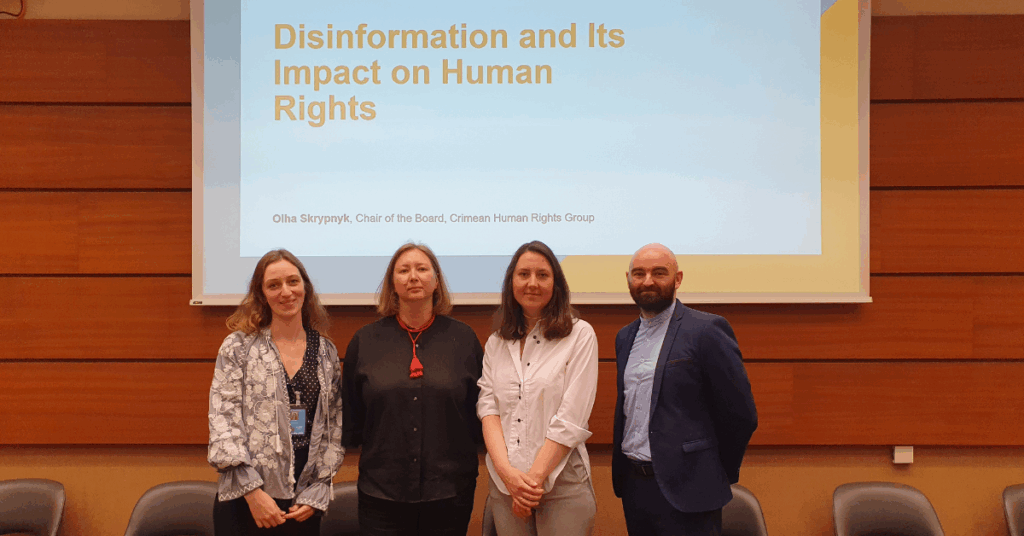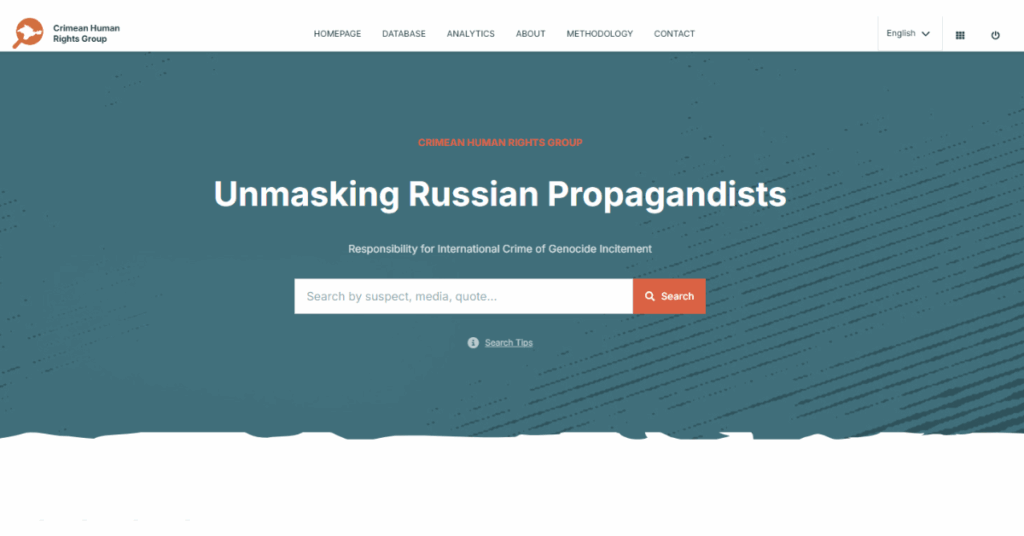In today’s interconnected world, disinformation erodes public trust, undermines human rights, and fuels violence. It is not merely a communication problem but a deliberate strategy used by states and other actors to manipulate reality and obstruct accountability.
On 19 June 2025, during the 59th session of the Human Rights Council (HRC59), HURIDOCS and the Crimean Human Rights Group (CHRG) co-organised the side event Combatting Disinformation in the Context of the Russia–Ukraine War. The event brought together civil society leaders, journalists, legal experts, diplomatic delegations, international advocates and independent experts, including Mariana Katzarovar, UN Special Rapporteur on the situation of human rights in the Russian Federation, to examine how disinformation campaigns—especially those driven by state propaganda—contribute to human rights violations, war crimes, and crimes against humanity. While the conversation focused on Ukraine, it also stressed that state-driven disinformation campaigns are a global threat.
The session began with a focus on the need for collaboration in documenting and countering disinformation. I shared how at HURIDOCS we work with partners like CHRG to create tools that preserve evidence and support those harmed by propaganda. Unmasking Russian Propagandists is a database developed jointly with CHRG, which captures and analyses hate speech and incitement to violence in Russian-language media. This resource, available in Ukrainian and English, has become an essential tool for advocacy, legal processes, and public awareness.
Disinformation is not just a threat to truth—it’s a direct threat to human rights. But documentation, when carefully and ethically done, is a form of resistance. It creates a parallel narrative grounded in verified facts, which supports accountability and strengthens institutional memory.
Olga Skrypnyk, Chair of the Crimean Human Rights Group’s Board, shared the findings of over a decade of monitoring Russian media. Since 2014, CHRG has documented politically motivated persecution in Crimea, where propaganda videos have routinely violated the presumption of innocence, portraying Ukrainians, Crimean Tatars, and activists as “terrorists,” “spies,” or “saboteurs.”
Olga reflected that after Russia’s full-scale invasion of Ukraine, the tone of Russian media became overtly hostile, abandoning even the pretence of journalistic standards. Direct hate speech and explicit calls for violence have become mainstream. She presented examples of prominent Russian media figures calling for the extermination of Ukrainians and the destruction of civilian infrastructure. These narratives, she explained, are now codified in policy, such as the 2024 Russian decree on “Countering Extremism,” which allows for the prosecution and deportation of Ukrainians from occupied territories under charges of “Russophobia.”Olga warned that this propaganda extends beyond Ukraine. Russian state-controlled media has increasingly normalised the idea of aggression against Europe, with calls to bomb decision-making centres and cities supplying weapons to Ukraine.
“These narratives do not just manipulate opinion—they incite violence, normalise atrocities, and endanger the entire European security architecture.”
—Olga Skrypnyk, Chair of the Crimean Human Rights Group’s Board

Anna Mykytenko, an international criminal and humanitarian law expert, expanded the discussion by emphasising that Russia’s tactics are not unique.
“Russia is one of many states that fight truth and promote violence through disinformation. Ownership and control of media platforms, restrictive laws, and propaganda enable governments to silence dissent and pave the way for human rights abuses.”
—Anna Mykytenko, International criminal and humanitarian law expert
She described how Russia’s disinformation campaign against Ukraine, which began long before the annexation of Crimea, has been a central element of its attempt to coerce Ukraine into submission. Stopping such campaigns during active conflict, Anna warned, is extremely difficult. “The time to act is before disinformation becomes widespread. Waiting until the damage is done—until millions are impacted—is too late,” she added.
Anna called on the international community to strengthen legal frameworks that draw clear lines between freedom of expression and harmful disinformation, to improve monitoring of state-run propaganda, and to hold accountable those who incite violence or war crimes. She also stressed the importance of demanding greater transparency and responsibility from social media platforms, supporting independent journalism, and building partnerships between governments, NGOs, and tech companies to combat online propaganda.
Matthew Jones from the Human Rights House Foundation reminded participants that disinformation campaigns undermine democracy itself. “This is a global issue. Without facts, there is no truth. Without truth, no trust. And without trust, democracy and our shared reality collapse,” he said, echoing the words of Nobel laureate Maria Ressa. He pointed to the critical role of independent media and digital literacy in countering propaganda, stressing that no single actor—whether a state, a civil society group, or a technology company—can tackle this problem alone.
The side event at HRC59 underscored a vital message: the fight against disinformation is inseparable from the fight for human rights. Our voices converged on the same point: disinformation is not only about shaping narratives, it is about enabling and justifying violence. To combat it, the international community must invest in robust documentation systems, legal accountability, cross-border collaboration, and support for independent media.
Explore the Unmasking Russian Propagandists database, which catalogues hundreds of documented cases of hate speech and incitement to violence, serving as both a public resource and a tool for accountability.

Read Oleksandra Kovalenko’s blog post on The harmful effects of disinformation and how to combat them.
